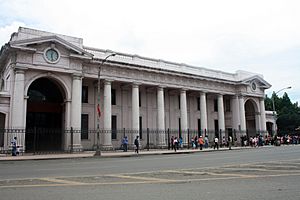Reina Torres de Araúz facts for kids
Quick facts for kids
Reina Torres de Araúz
|
|
|---|---|
| Born |
Reina Cristina Torres Pérez
October 30, 1932 |
| Died | February 26, 1982 (aged 49) |
| Occupation | Anthropologist, ethnographer and professor |
| Spouse(s) | Amado Araúz |
| Children | Oscar Araúz Hernán Araúz Carmela Araúz |
Reina Cristina Torres de Araúz (born October 30, 1932, died February 26, 1982) was a very important Panamanian scientist. She was an anthropologist, which means she studied human societies and cultures. She was also an ethnographer, someone who studies and describes specific cultures. People remember her as a strong defender of Panama's history and culture.
Contents
About Reina Torres de Araúz
Her Early Life and Studies
Reina Torres de Araúz was born in Panama City on October 30, 1932. She went to school in Panama, including the National Institute. Later, she traveled to Argentina to study at the University of Buenos Aires.
There, she earned her doctorate in 1963, focusing on philosophy and anthropology. She also became an expert in ethnography and museum studies. Her doctoral paper, written in 1962, was about the cultures of Panama and Colombia. It is still an important source of information today. Reina was very smart and could speak five languages, even ancient Greek and Latin!
Her Important Career Work

Reina Torres de Araúz spent her career studying the native people of Panama. She visited them in jungles and mountains. She learned about their daily lives, beliefs, games, dances, songs, and music. She kept detailed notes and took many photos. Her main goal was to help protect these indigenous cultures.
She taught anthropology at the National Institute and the University of Panama. At the university, she started the Center for Anthropological Research. She also helped create the National Commission of Archaeology and Historic Monuments. This commission later became the National Historical Heritage. Reina led this group for ten years.
During her time as director, she helped pass Law 14 in 1982. This law helps protect and manage Panama's national treasures.
Reina was also chosen as Vice President of the World Heritage Committee for UNESCO. This group works to protect important places around the world. In 1974, she became the first Panamanian woman to be a full member of the Panamanian Academy of History. She also helped create several museums, like:
- The Museum of the Archaeological Park El Caño
- The Museum of the Nationality of the Villa de Los Santos
- The Museum of Colonial Religious Art
- The West Indian Museum of Panama
- The Museum of Natural Science and History Museum of Panama
Fighting for Panama's Heritage
Reina Torres de Araúz worked hard to stop people from illegally taking old artifacts from Panama. She even wrote to museums in America, asking them to return Panamanian treasures.
In 1979, a train engine called locomotive 299 was moved from Panama to a museum in New Jersey. This engine was part of the first railway across Panama. Reina was very upset because this engine was considered part of Panama's national heritage. She felt it was wrong to take it, especially since Panama was gaining more control over its land. She called it "a clear violation" of rules about world heritage.
Her Personal Life
Reina met Professor Amado Arauz in 1958. They were both doing research on native people in the Darién Province. They got married on December 30, 1959. They had three children together.
Soon after they married, they went on an amazing trip. They were part of the first group to drive a car from Panama to Bogotá. This journey, called the "Trans-Darien Expedition," took them four months and twenty days through the jungles of Darien and Choco.
Her Final Years
In the early 1980s, Reina faced a very sad time when her oldest son, Oscar, passed away. Soon after, Reina herself became very ill. She bravely fought her illness for about two and a half years.
Reina passed away on February 26, 1982, when she was 49 years old. Even during her illness, she kept working hard. Her last projects included choosing items for the Museum of Chitre and writing a new book called "The New Edinburgh Darien." She worked until the very end, showing her dedication to Panama's history and culture.
See also
 In Spanish: Reina Torres de Araúz para niños
In Spanish: Reina Torres de Araúz para niños



